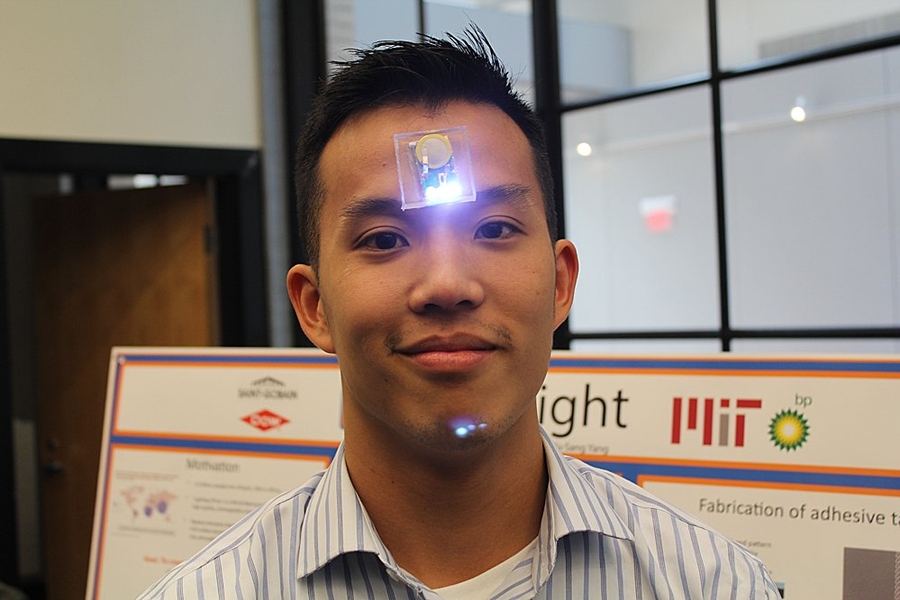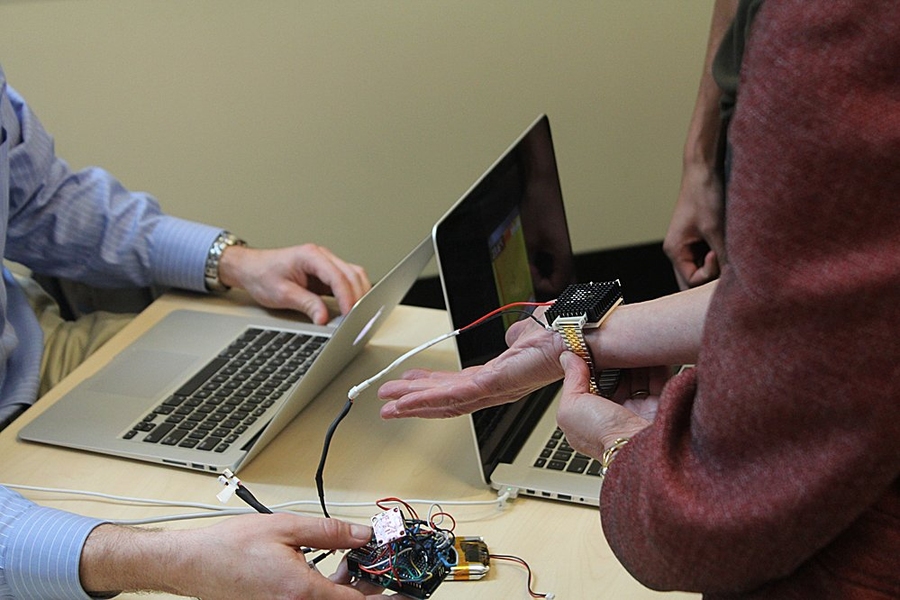Heating or cooling certain parts of your body — such as applying a warm towel to your forehead if you feel chilly — can help maintain your perceived thermal comfort.
Using that concept, four MIT engineering students developed a thermoelectric bracelet that monitors air and skin temperature, and sends tailored pulses of hot or cold waveforms to the wrist to help maintain thermal comfort.
For this invention, the team, called Wristify, took home the $10,000 first prize at this year’s MADMEC, MIT’s annual materials-science design competition, held Tuesday afternoon.
The product is now a working prototype. And although people would use the device for personal comfort, the team says the ultimate aim is to reduce the energy consumption of buildings, by cooling and heating the individual — not the building.
“Buildings right now use an incredible amount of energy just in space heating and cooling. In fact, all together this makes up 16.5 percent of all U.S. primary energy consumption. We wanted to reduce that number, while maintaining individual thermal comfort,” says Sam Shames, a materials science and engineering senior who co-invented the Wristify technology. “We found the best way to do it was local heating and cooling of parts of the body.”
The team estimates that if the device stops one building from adjusting its temperature by even just 1 degree Celsius, it will save roughly 100 kilowatt-hours per month.
The annual competition, now in its seventh year, is run by MIT’s Department of Materials Science and Engineering (DMSE), and is sponsored by Saint Gobain, BP, and Dow Chemical. The contest’s theme this year was “materials science solutions for sustainability.”
After the competition, some teams may further develop their products, or even take them to market. But the primary aim of the competition is to engage students in prototyping and design, says Michael Tarkanian, a lecturer in DMSE who runs MADMEC.
“The goal is to allow students to get their hands dirty, working in the labs to design and build functional prototypes,” he says. “It gives them an opportunity to put their classroom knowledge to work, solving problems related to energy, habitat, and sustainability.”
Leveraging human sensitivity
For the competition, teams of two to five MIT students receive $1,000 to build their prototypes. Starting in June, monthly checkpoints and several independent design challenges are organized to help guide the teams in the development process.
Over the course of developing its technology, the Wristify team made a key discovery: Human skin is very sensitive to minute, rapid changes in temperature, which affect the whole body. They found they needed to heat or cool any body part (in their case, the wrist) at a rate of at least 0.1 C per second in order to make the entire body, overall, feel several degrees warmer or colder.
After 15 prototypes, the team landed on its final product, which resembles a wristwatch and can be powered, for up to eight hours, by a lithium polymer battery. This prototype demonstrated a rate of change of up to 0.4 C per second.
The “watch” part of the prototype actually consists of the team’s custom copper-alloy-based heat sink (a component that lowers a device’s temperature by dissipating heat). Attached is an automated control system that manages the intensity and duration of the thermal pulses delivered to the heat sink. Integrated thermometers also measure external and body temperature to adjust accordingly.
“What we developed is a wearable, wrist-based technology that leverages human sensitivity, can detect and perfect rates of change, and can maintain overall thermal comfort while reducing the need to heat and cool buildings,” Shames says.
With the prize money, the team plans to further develop the prototype, using advanced algorithms to better automate the thermal pulses, among other things. Other Wristify co-inventors from DMSE include graduate students Mike Gibson and David Cohen-Tanugi, and postdoc Matt Smith.
Everybody wins
Two other teams won second and third place prizes, earning $6,000 and $4,000, respectively. Taking second place was GeckoLight, a team of four engineering students who developed inexpensive, small LED lights — powered by solar-powered, rechargeable batteries — that can stick to any surface, including skin.
The sticky material on the back of the lights is based on geckos’ feet — which are equipped with a forest of small hairs that stick to surfaces — and the fine filaments mussels use to dangle on rocks without breaking loose. The team’s idea is to replace kerosene-based fuels that release 19 million tons of carbon dioxide into the atmosphere per year — especially in developing countries.
Third-place prize went to PolySolar, a team of students who developed a concept for polymer-based solar cells that are inexpensive, efficient, and can adhere to any surface.
Three other teams competed in the contest. EZ Iron experimented with creating metal from powder. Another team, Infilterators, bonded amino acids with carbon to create a polymer that can be applied to water filters to remove heavy metal ions, such as lead and mercury. And Therminator combined graphene oxide with carbon nanotubes to create thin films that can be applied to silicon chips to help them cool faster.
Some former MADMEC teams have gone on to start companies to commercialize their inventions. One successful example has been Levant Power, which placed third in the first MADMEC, in 2007. The company, which designed shock absorbers that improve vehicle handling while generating electricity to improve overall efficiency, has performed successful tests with the U.S. military and with city buses in New York.
Using that concept, four MIT engineering students developed a thermoelectric bracelet that monitors air and skin temperature, and sends tailored pulses of hot or cold waveforms to the wrist to help maintain thermal comfort.
For this invention, the team, called Wristify, took home the $10,000 first prize at this year’s MADMEC, MIT’s annual materials-science design competition, held Tuesday afternoon.
The product is now a working prototype. And although people would use the device for personal comfort, the team says the ultimate aim is to reduce the energy consumption of buildings, by cooling and heating the individual — not the building.
“Buildings right now use an incredible amount of energy just in space heating and cooling. In fact, all together this makes up 16.5 percent of all U.S. primary energy consumption. We wanted to reduce that number, while maintaining individual thermal comfort,” says Sam Shames, a materials science and engineering senior who co-invented the Wristify technology. “We found the best way to do it was local heating and cooling of parts of the body.”
The team estimates that if the device stops one building from adjusting its temperature by even just 1 degree Celsius, it will save roughly 100 kilowatt-hours per month.
The annual competition, now in its seventh year, is run by MIT’s Department of Materials Science and Engineering (DMSE), and is sponsored by Saint Gobain, BP, and Dow Chemical. The contest’s theme this year was “materials science solutions for sustainability.”
After the competition, some teams may further develop their products, or even take them to market. But the primary aim of the competition is to engage students in prototyping and design, says Michael Tarkanian, a lecturer in DMSE who runs MADMEC.
“The goal is to allow students to get their hands dirty, working in the labs to design and build functional prototypes,” he says. “It gives them an opportunity to put their classroom knowledge to work, solving problems related to energy, habitat, and sustainability.”
Leveraging human sensitivity
For the competition, teams of two to five MIT students receive $1,000 to build their prototypes. Starting in June, monthly checkpoints and several independent design challenges are organized to help guide the teams in the development process.
Over the course of developing its technology, the Wristify team made a key discovery: Human skin is very sensitive to minute, rapid changes in temperature, which affect the whole body. They found they needed to heat or cool any body part (in their case, the wrist) at a rate of at least 0.1 C per second in order to make the entire body, overall, feel several degrees warmer or colder.
After 15 prototypes, the team landed on its final product, which resembles a wristwatch and can be powered, for up to eight hours, by a lithium polymer battery. This prototype demonstrated a rate of change of up to 0.4 C per second.
The “watch” part of the prototype actually consists of the team’s custom copper-alloy-based heat sink (a component that lowers a device’s temperature by dissipating heat). Attached is an automated control system that manages the intensity and duration of the thermal pulses delivered to the heat sink. Integrated thermometers also measure external and body temperature to adjust accordingly.
“What we developed is a wearable, wrist-based technology that leverages human sensitivity, can detect and perfect rates of change, and can maintain overall thermal comfort while reducing the need to heat and cool buildings,” Shames says.
With the prize money, the team plans to further develop the prototype, using advanced algorithms to better automate the thermal pulses, among other things. Other Wristify co-inventors from DMSE include graduate students Mike Gibson and David Cohen-Tanugi, and postdoc Matt Smith.
Everybody wins
Two other teams won second and third place prizes, earning $6,000 and $4,000, respectively. Taking second place was GeckoLight, a team of four engineering students who developed inexpensive, small LED lights — powered by solar-powered, rechargeable batteries — that can stick to any surface, including skin.
The sticky material on the back of the lights is based on geckos’ feet — which are equipped with a forest of small hairs that stick to surfaces — and the fine filaments mussels use to dangle on rocks without breaking loose. The team’s idea is to replace kerosene-based fuels that release 19 million tons of carbon dioxide into the atmosphere per year — especially in developing countries.
Third-place prize went to PolySolar, a team of students who developed a concept for polymer-based solar cells that are inexpensive, efficient, and can adhere to any surface.
Three other teams competed in the contest. EZ Iron experimented with creating metal from powder. Another team, Infilterators, bonded amino acids with carbon to create a polymer that can be applied to water filters to remove heavy metal ions, such as lead and mercury. And Therminator combined graphene oxide with carbon nanotubes to create thin films that can be applied to silicon chips to help them cool faster.
Some former MADMEC teams have gone on to start companies to commercialize their inventions. One successful example has been Levant Power, which placed third in the first MADMEC, in 2007. The company, which designed shock absorbers that improve vehicle handling while generating electricity to improve overall efficiency, has performed successful tests with the U.S. military and with city buses in New York.







